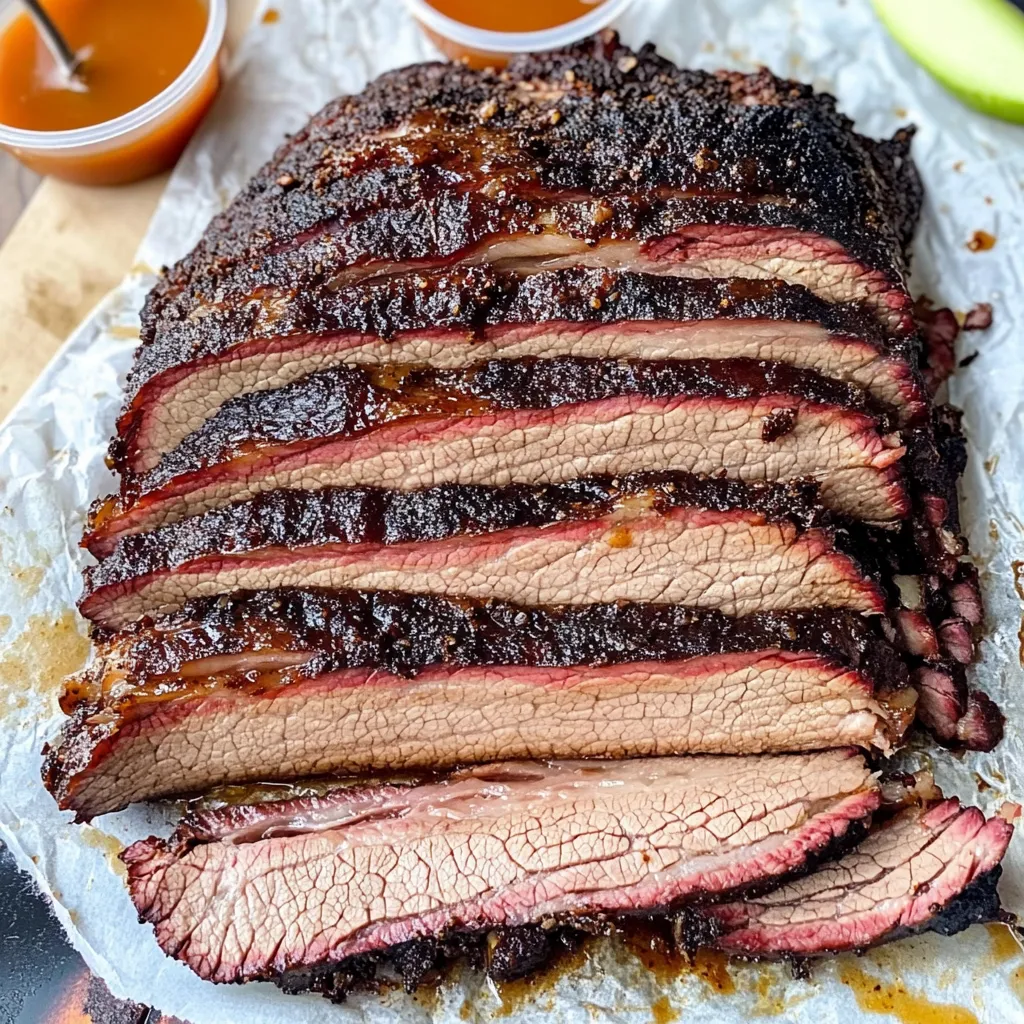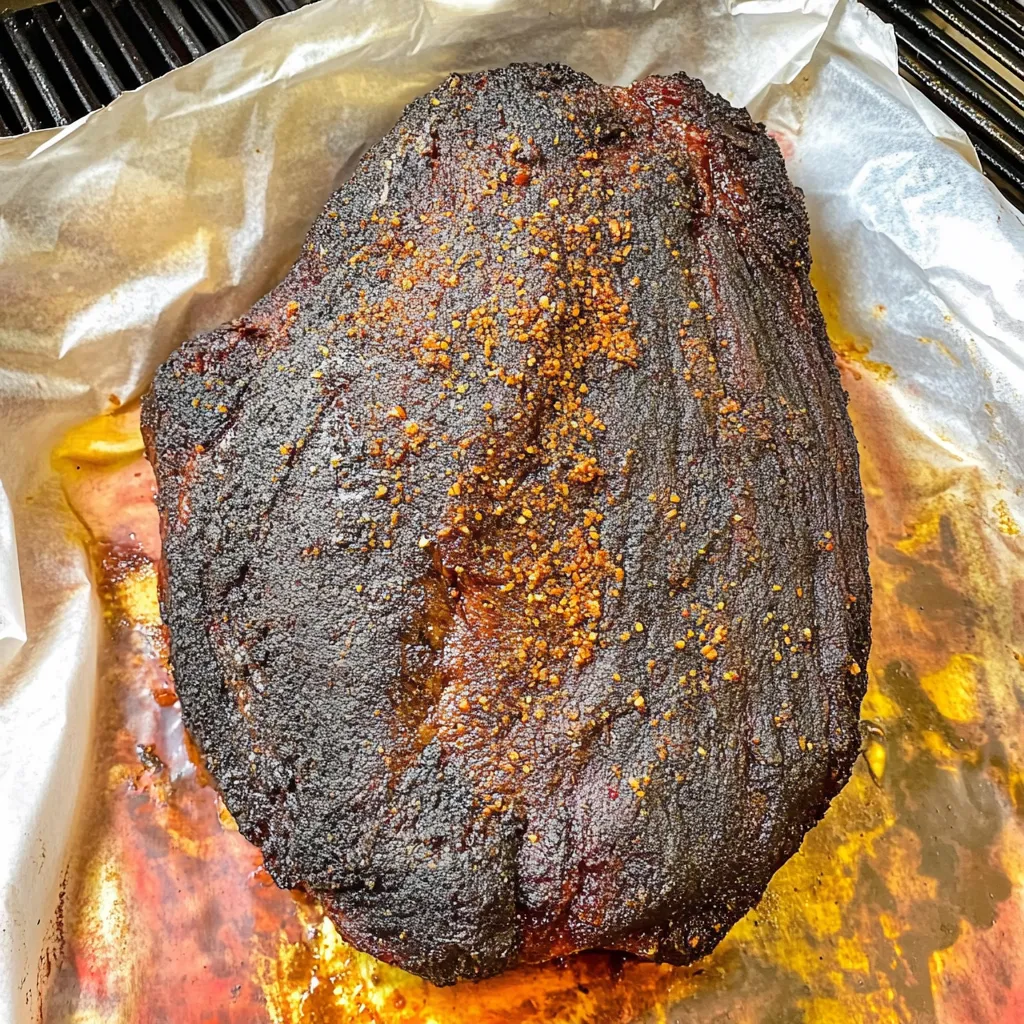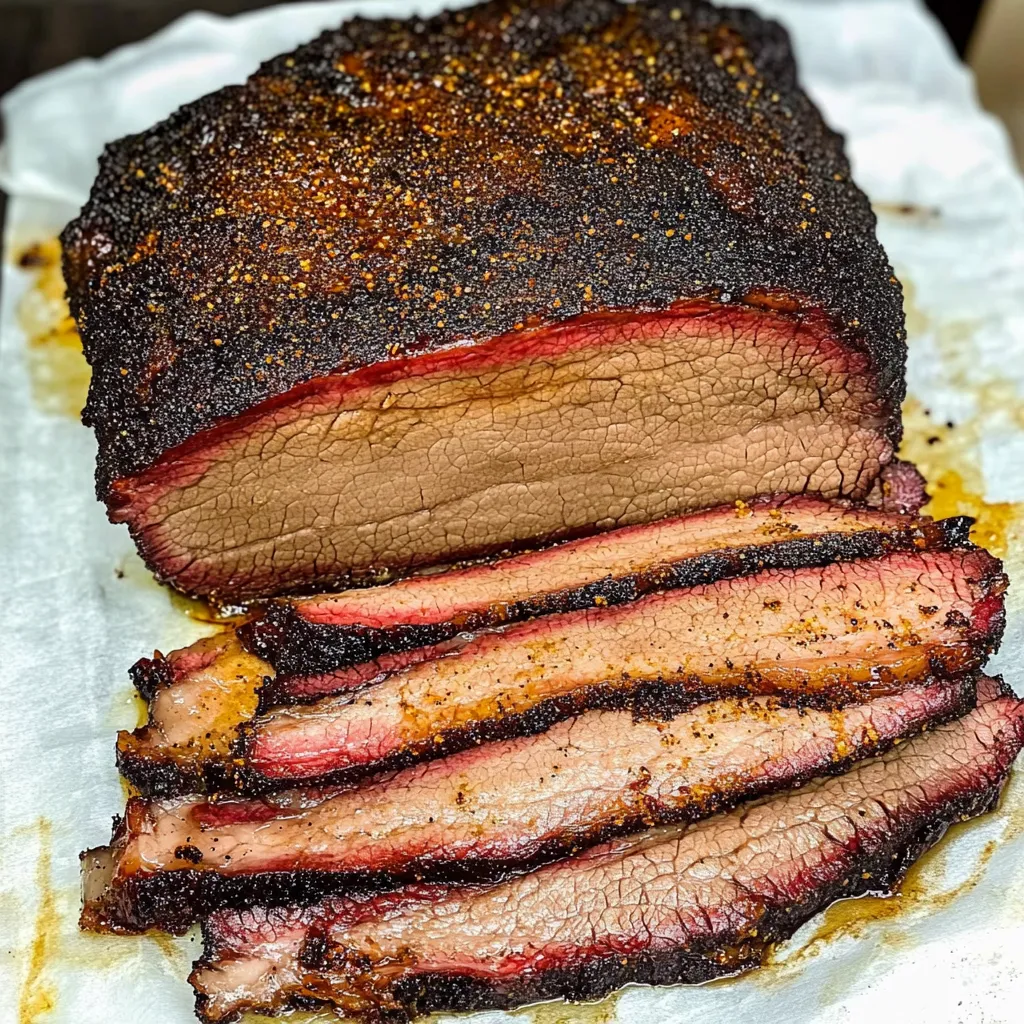 Pin it
Pin it
This Texas-style smoked brisket delivers tender, juicy beef with a flavorful crust after 12 hours of low and slow smoking. The garlic butter injection keeps the meat moist from the inside while the spice rub creates that signature bark on the outside. Every slice reveals the smoke ring and melts in your mouth with rich, beefy flavor that makes the long cooking time completely worthwhile.
I make this for major summer holidays when I want something that feels special and brings people together. The first time I successfully smoked a brisket, I understood why Texans take their barbecue so seriously - there's nothing quite like slicing into meat you've spent all day tending. Now it's become my signature dish for celebrations.
Essential Ingredients and Equipment
- Packer cut brisket: 10-pound whole brisket including both the flat and point sections
- Melted butter: For the injection that keeps meat moist internally
- Garlic powder and Cajun seasoning: Flavor the butter injection
- Dry rub spices: Seasoned salt, onion powder, black pepper, garlic powder, paprika
- Apple juice and cider vinegar: Creates the spritz that develops the bark
- Meat injector: Essential for getting butter deep into the meat
- Spray bottle: For applying the apple juice mixture
- Butcher paper: Wraps the brisket during the second half of smoking
- Meat thermometer: Crucial for checking doneness at 205°F
Complete Step-by-Step Instructions
- Preheat and prepare:
- Fire up your grill or smoker to 225°F, maintaining steady temperature. Keep the brisket refrigerated until ready to trim - cold fat is much easier to cut cleanly. While the grill heats, gather all your equipment and prepare your injection and rub.
- Trim the fat cap properly:
- Remove the brisket from the fridge and place on a large cutting board. Using a sharp knife, trim excess fat from the brisket, leaving about 1/4 inch of the fat cap intact. This thin layer bastes the meat as it renders during smoking. Don't remove too much or the brisket will dry out.
- Inject with garlic butter:
- Mix 1/2 cup melted butter with 2 tablespoons garlic powder and 1 tablespoon Cajun seasoning. Load the mixture into a meat injector and inject the brisket at multiple points about 1-2 inches deep, spacing injections evenly across the entire brisket until all the butter is used. This keeps the interior moist during the long cook.
- Apply the dry rub generously:
- In a bowl, combine 2 tablespoons seasoned salt, 2 tablespoons onion powder, 2 tablespoons black pepper, 2 tablespoons garlic powder, and 2 tablespoons paprika. Coat the entire brisket with this rub, patting it firmly so it adheres to the meat and creates a good crust. Don't be shy - you want complete coverage.
- Start the smoke:
- Place the brisket fat-side up directly on the grill grates. Close the lid and smoke for 3 hours without opening. Resist the temptation to check on it - maintaining consistent temperature is crucial. The brisket will develop a dark crust during this time.
- Spritz after 3 hours:
- Mix equal parts apple juice and apple cider vinegar in a spray bottle. After 3 hours, quickly open the grill and spray the brisket generously all over. Close the lid immediately and continue smoking for another 3 hours without opening.
- Wrap at the 6-hour mark:
- After a total of 6 hours of smoking, remove the brisket from the grill. Spray it down one more time, then wrap it tightly in butcher paper, making sure there are no gaps where juices could escape. Aluminum foil works too if you don't have butcher paper.
- Continue smoking wrapped:
- Return the wrapped brisket to the grill and smoke for approximately 6 more hours. Insert a meat thermometer through the paper to check temperature - you're looking for an internal temperature of at least 205°F. This is when the connective tissue has fully broken down.
- Rest before slicing:
- Once the brisket reaches 205°F, remove it from the grill. Open the wrapping just enough to vent but keep it mostly covered. Let rest for 1 full hour - this allows juices to redistribute throughout the meat. Skipping this step results in dry brisket.
- Slice against the grain:
- Using a very sharp knife or electric knife, separate the flat from the point. Slice the flat straight down into thin slices. Turn the point at an angle and slice against the grain. Cutting against the grain is essential for tender slices.
 Pin it
Pin it
The transformation over those 12 hours is remarkable - tough, sinewy meat becomes so tender it practically falls apart. The smell during smoking fills the entire neighborhood and draws everyone outside. I love how the butcher paper wrap creates that perfect bark while keeping everything juicy inside.
Understanding Brisket Anatomy
The packer cut includes two muscles: the flat (leaner) and the point (fattier). They have different grain directions, which is why you separate them before slicing. The flat provides neat, uniform slices while the point is great for burnt ends or chopped beef.
Mastering Temperature Control
Maintaining steady 225°F is critical for breaking down tough connective tissue without drying out the meat. Temperature fluctuations extend cooking time and can create uneven results. Use a reliable thermometer to monitor both grill temperature and internal meat temperature.
Recognizing the Stall
Around 160-170°F internal temperature, the brisket will "stall" - temperature stops rising for hours. This happens as moisture evaporates and cools the meat. Wrapping at 6 hours helps push through this stall by trapping heat and moisture.
Developing Proper Bark
The bark - that dark, crusty exterior - develops from the rub combining with smoke and rendered fat. The spritz helps set the rub and adds flavor while preventing burning. Too much spritz washes off the rub, so spray lightly but thoroughly.
Storage and Reheating Tips
Refrigerate leftover brisket wrapped tightly for up to 5 days. To reheat without drying out, wrap slices in foil with a splash of beef broth and warm in a 300°F oven for 20-30 minutes. The microwave works but won't maintain the texture as well.
 Pin it
Pin it
This recipe represents a time investment that delivers results you simply cannot achieve any other way. The low and slow method is what transforms one of the toughest cuts of beef into something legendary. It's worth every hour spent tending the fire to create something that brings people together and creates memories.
Frequently Asked Questions
- → How long does it take to smoke a 10-pound brisket?
- Plan for about 12 hours of total smoking time at 225°F. This includes the initial smoke, basting, and the final wrapped cook. Always check that the internal temperature reaches 205°F.
- → Should I wrap my brisket in foil or butcher paper?
- Butcher paper is preferred for Texas-style brisket because it lets the meat breathe while still locking in moisture. Foil works too, but it can make the bark softer.
- → Do I need to flip the brisket while smoking?
- No, keep the brisket fat side up throughout the entire cook. Flipping it opens the smoker too much and lets out valuable heat and smoke.
- → Why do you inject the brisket with butter?
- The butter injection adds flavor deep inside the meat and helps keep it moist during the long smoking process. It's especially helpful for leaner briskets.
- → What temperature should the brisket reach when done?
- Your brisket should reach an internal temperature of at least 205°F. At this point, the collagen has broken down and the meat will be tender enough to slice easily.
- → Can I make this brisket in a regular oven?
- While you won't get the same smoky flavor, you can cook brisket in the oven at 225°F following the same time guidelines. Consider using liquid smoke in your injection for flavor.
- → How do I know which way the grain runs?
- Look at the brisket and you'll see lines running in one direction. That's the grain. Slice perpendicular to those lines for the most tender pieces.
